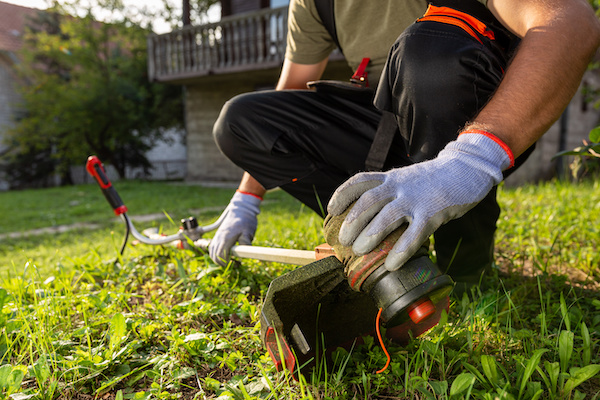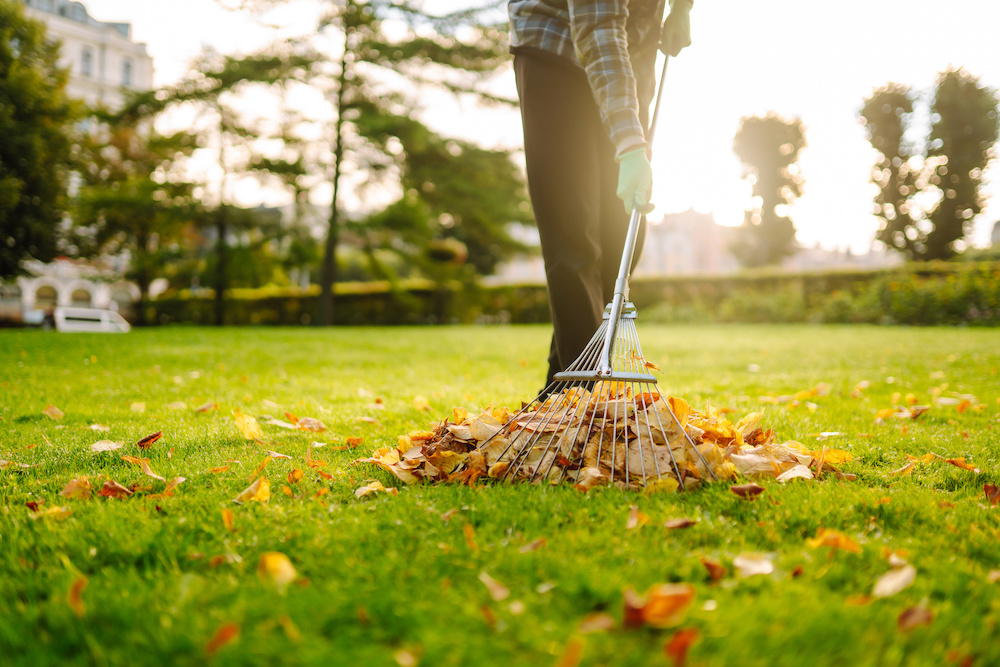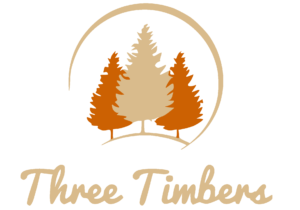Are you ready to revitalize your lawn this fall? A well-maintained yard not only enhances your home’s curb appeal, but also promotes a healthy environment for your family. Our Fall Yard Maintenance Guide will help you or a local company transform your lawn into a lush, healthy oasis by providing expert tips on nourishment, weed control, leaf management, and more. Let’s dive in!
Short Summary
- Nourish your lawn in early fall for a healthy and vibrant outdoor space all year round.
- Choose the right fertilizer, apply it at the correct time, and practice leaf management to tackle weeds & pests.
- Hire a professional yard maintenance company to ensure optimal yard maintenance this season!

Early Fall Lawn Nourishment
Early fall is the perfect time to give your lawn a much-needed boost after a long, hot summer. Fertilizing in early fall helps rebuild grassroots weakened by the heat, providing a strong foundation for the upcoming winter months. By nourishing your lawn now, you’ll ensure it stays healthy throughout the winter and thrives come spring.
But what kind of fertilizer should you use, and when should you apply it? Let’s find out.
Choosing the Right Fertilizer
Selecting the right fertilizer is crucial for maximizing your lawn’s potential. While there are various types of fertilizers available, such as organic and inorganic, a product like Scotts® Turf Builder® WinterGuard® Fall Weed & Feed3 is an excellent choice for early fall. This fertilizer provides essential nutrients, promotes root growth, and even tackles pesky weeds.
However, if you have a St. Augustine, zoysia, or centipedegrass lawn, you’ll need a different product tailored to those specific grass types.
Timing and Application
Timing is everything when it comes to applying fall fertilizer. For the best possible outcome, apply the fertilizer between August 15 and November 1, 6 to 8 weeks after your summer feeding. Don’t wait until winter hits; instead, apply it 2 to 3 weeks before the ground freezes for optimal results.
In addition, it’s best to fertilize your lawn again 6-8 weeks after your initial fall fertilization to help it recover from the summer stress and prepare for the winter months.
Revitalize Your Yard
As the seasons change, so do the needs of your lawn. Depending on the type of grass you have, your fall lawn care routine may require different approaches. Cool-season grasses like Kentucky bluegrass, perennial ryegrass, and tall and fine fescues need a fall feeding to ensure they have the necessary nutrients for a healthy spring.
On the other hand, warm-season grasses such as Bermuda grass need to be overseeded with cool-season grasses to maintain a green and lush appearance.
Let’s take a closer look at how to care for both cool-season and warm-season grasses.
Cool Season Grass Care
Fall is an excellent opportunity to establish new grass and reinforce existing lawns for cool-season grasses like Kentucky bluegrass, perennial ryegrass, fine fescue, and tall fescue. One of the most effective cool-season lawn care tips is to practice plug aeration and spike aeration. These techniques reduce soil compaction, allowing essential nutrients, oxygen, and water to reach the grassroots, promoting a healthy and vibrant lawn.
Another helpful tip for cool-season lawns is to take advantage of the fall season to remove excess thatch. Thatch is a layer of organic material that accumulates between the soil surface and grass blades. If the thatch layer becomes too thick, it can prevent water, nutrients, and oxygen from reaching the grassroots. Fall is the perfect time to address this issue and ensure your cool-season lawn is ready to thrive come spring.
Warm Season Grass Care
Caring for warm-season grasses like Bermuda grass is essential to ensure they thrive in warmer climates. Aerating and dethatching warm-season lawns in the spring can help keep your lawn looking lush and healthy. Another crucial step for maintaining a green and vibrant warm-season lawn during the winter months is overseeding. Overseeding involves spreading cool-season grass seeds, such as annual or perennial ryegrass, over a dormant lawn.
To get the most out of your overseeding efforts, start two to four weeks before the first killing frost. While both annual and perennial ryegrass can be used for overseeding, perennial ryegrass is more resilient to cold, disease, and drought, making it an ideal choice for your lawn. However, if you have a Zoysia, centipede, or St. Augustine lawn, Bermuda grass is the most reliable option for overseeding compared to other grass types.

Leaf Management for a Healthy Lawn
As autumn approaches, fallen leaves can become a nuisance, and if left unattended, they can suffocate your lawn and create a breeding ground for pests and diseases. One effective way to manage leaves on your lawn is by mulching them into dime-sized pieces with a lawnmower. This helps the soil microbes break down the leaves, promoting healthy soil conditions.
Once mulched, leaves can be added to a compost pile or used as soil enrichment, both of which will be incredibly beneficial for your garden. Let’s explore some effective mulching and composting techniques.
Mulching Techniques
Mulching can be done using various techniques, such as organic and inorganic mulches. Organic mulches like bark, wood chips, grass clippings, straw, garden compost, shredded leaves, and pine needles are excellent options. Mulching not only helps to keep the soil moist, cut down on weeds, and shield plants from extreme temperatures, but also enhances soil structure and adds important nutrients to the soil.
Ensure you use the appropriate type and amount of mulch for your plants, spread it evenly, and keep it away from the base of the plants for optimal results. Additionally, avoid piling mulch too high, as this can prevent the plants from receiving enough air.
Composting Leaves
Composting leaves is an excellent way to recycle organic matter and enrich your garden’s soil. Collect the leaves, shred them, add them to a compost bin, and turn the compost regularly. Composting leaves can enhance soil structure, enrich the soil with essential nutrients, and minimize the amount of waste sent to landfills, making it an environmentally friendly option.
By composting leaves, you’re not only helping your garden, but also contributing to a greener planet.
Tackling Lawn Weeds and Pests
A healthy lawn isn’t just about proper nourishment and leaf management; it also involves keeping weeds and pests at bay. Pre-emergent weed control can help you maintain a weed-free lawn, while insect and disease prevention techniques provide a proactive approach to protect your lawn from potential damage caused by insects and diseases.
Let’s delve deeper into pre-emergent weed control and insect and disease prevention techniques to ensure a healthy and vibrant lawn.
Pre-emergent Weed Control
Pre-emergent weed control works by applying a herbicide to the soil before weeds have a chance to sprout, preventing them from germinating and growing. Effective herbicides like prodiamine, dithiopyr, trifluralin, siduron, isoxaben, and pendimethalin come in convenient forms like liquid, granular, and water-soluble for your convenience.
To ensure the best results, apply the pre-emergent weed control when the soil temperature is between 50-65 degrees Fahrenheit, either in early spring or late fall. By implementing pre-emergent weed control, you can enjoy a weed-free, healthy lawn while saving time and effort in lawn maintenance.
Insect and Disease Prevention
Insect and disease prevention involves a combination of cultural practices, chemical treatments, and biological control methods. Cultural practices such as proper irrigation, fertilization, mowing, soil cultivation, and thatch removal can help keep insects and diseases at bay.
Chemical treatments, including fungicides and insecticides, can efficiently control pests and diseases when needed. Biological control methods, like the use of beneficial nematodes and biological insecticide products, can also help control pests in an eco-friendly way.
By incorporating these methods, you can protect your lawn from unwanted pests and diseases and maintain a healthy, beautiful outdoor space.
Adjusting Mowing Practices
Adjusting your mowing practices can significantly impact your lawn’s overall health and appearance. Proper mowing height promotes deeper root growth, making your lawn stronger and more resilient in the long run.
As the fall season progresses, it’s essential to cut your lawn slightly shorter for the final mowing of the year, ensuring a lush and healthy lawn come spring. Let’s explore the benefits of shorter mowing and the importance of mowing frequency.
Benefits of Shorter Mowing
Shorter mowing can instantly enhance the look of your lawn, giving it a neat and tidy appearance. However, shorter mowing can also make your lawn more prone to weed infestations.
On the other hand, longer grass promotes more photosynthesis, which helps develop stronger roots and creates a healthier lawn overall. Moreover, longer grass blades provide shade to the ground, keeping it cooler and retaining moisture, preventing it from drying out too quickly.
Finding the right balance between short and long grass is key to maintaining a healthy lawn. While shorter mowing can improve the appearance of your yard, it’s essential not to cut the grass too short. Instead, focus on maintaining a consistent mowing height that allows for optimal photosynthesis and root development, keeping your lawn lush and healthy throughout the year.
Mowing Frequency
The frequency of mowing can be tailored to your individual needs based on the mowing height and growth rate of your selected grass species. To maintain a neat and healthy lawn, aim for a mowing frequency of once every 4 – 7 days between March and October, with weekly or fortnightly mowing being ideal for most lawns.
To ensure the health of your lawn, never remove more than one-third of the grass height at any one mowing. By adhering to these guidelines, you’ll maintain a beautiful and resilient lawn throughout the year.
Preparing Your Yard for Winter
As winter approaches, it’s essential to prepare your yard for the colder months ahead. Storing lawn furniture and cleaning gutters are just a few of the necessary steps to ensure your outdoor space remains in optimal condition despite the harsh winter elements.
Let’s discuss how to store your lawn furniture and maintain your gutters before winter arrives.
Storing Lawn Furniture
Proper storage of your lawn furniture is crucial for protecting it from the elements and prolonging its lifespan. Options such as patio and deck boxes, waterproof storage bags, outdoor storage benches, and covers are all excellent choices for storing your lawn furniture.
These storage solutions not only protect your furniture, but also help you maintain a clean and organized outdoor space during the winter months. By storing your lawn furniture correctly, you can enjoy it for many seasons to come.
Gutter Maintenance
Cleaning and maintaining your gutters before winter is vital for preventing clogs during winter storms and keeping your home safe and dry. Remove debris, check for damage, and flush the gutters for a thorough clean.
Inspect the gutters for clogs, assess for damage, and verify proper alignment. By performing these tasks, you can avoid potential issues caused by clogged or damaged gutters during the winter season.

Caring for Your Tools
Proper care for your tools is essential to ensure safety, extend the life of your equipment, increase productivity, reduce expenses, and enhance the quality of your work. Additionally, cleaning and sanitizing tools can prevent the spread of infection.
Before storing your tools for the winter, make sure they are clean and in good working order. Let’s explore how to clean your garden tools and winterize your lawn equipment.
Cleaning Garden Tools
To clean your garden tools effectively, you can use various methods such as washing with soap and water, using a stiff brush to remove dirt, using a hard spray of water or a pressurized sprayer, soaking in a bleach solution, using alcohol to sanitize, or soaking in vinegar. Make sure to wear protective gloves and safety glasses for your safety while cleaning your tools.
Additionally, it’s crucial to dry the tools after cleaning to prevent rusting and ensure they stay in top condition.
Winterizing Lawn Equipment
Winterizing your lawn equipment is essential for ensuring its smooth running and a quick start in the spring, making lawn care more manageable and enjoyable. To winterize your equipment, drain the fuel tank, change the oil, clean the air filter, and sharpen the blades.
Additionally, covering the equipment with a tarp or plastic sheet can help keep it in the best condition during the winter months. By caring for your tools and equipment, you can prolong their lifespan and ensure they are ready for use when the warmer months roll around.
Expert Assistance at Your Fingertips
If you’re looking for expert assistance or advice on your fall yard maintenance, you’re in luck! There are plenty of online resources and local experts available to help you with your lawn care needs. From eLearning platforms to local professionals, you can find the guidance and support you need to maintain a healthy and beautiful lawn throughout the year.
Local Experts
If you prefer a more personalized approach, local experts can be an invaluable resource for your fall yard maintenance needs. Professionals can provide specialized knowledge and guidance for tasks that may be difficult or unfamiliar.
By consulting a local professional, you can ensure your lawn care tasks are done correctly and efficiently, leading to a healthier lawn and a greater sense of satisfaction with the results.
Summary
In conclusion, fall yard maintenance is an essential aspect of ensuring a healthy and vibrant lawn throughout the year. By following this comprehensive guide, you’ll be well on your way to revitalizing your lawn with proper nourishment, weed and pest control, leaf management, and mowing practices. Don’t forget to care for your tools and prepare your yard for the winter months. With expert assistance just a click or call away, you can confidently tackle your fall yard maintenance and enjoy a lush, beautiful lawn all year round. Happy gardening!
Frequently Asked Questions
Should I do anything to my lawn in the fall?
Fall is an important season for caring for your lawn and fertilizing it is the best way to ensure a healthy start for the next growing season. Taking the time to give your lawn the nutrients it needs now can make a big difference in its appearance and vitality come spring.
Don’t miss out on this key opportunity to do something good for your lawn!
Should you fertilize your yard in the fall?
Yes, you should fertilize your yard in the fall! Applying fertilizer during this time helps to strengthen the roots of your grass and encourage growth, so that when spring arrives, your yard will be lush and green.
Fertilizing during autumn also increases the winter color of your stand and reduces winter damage.


